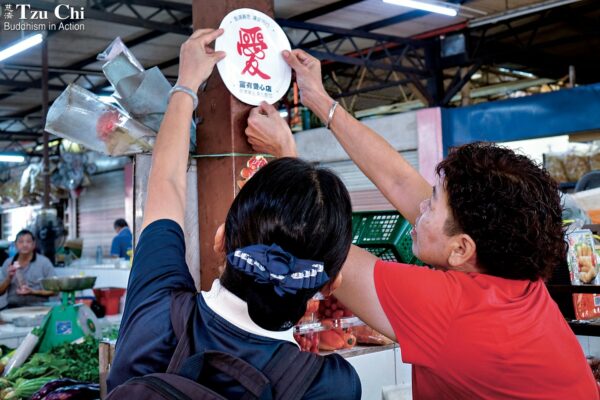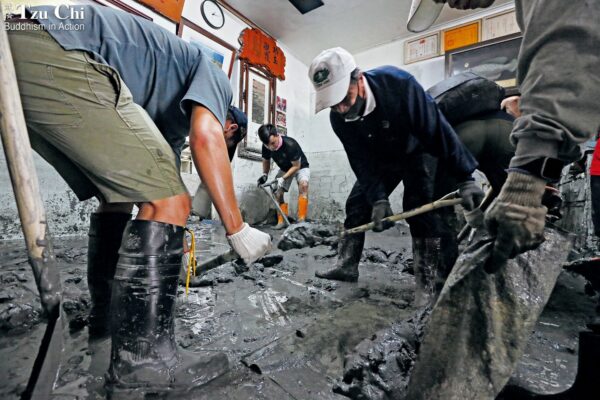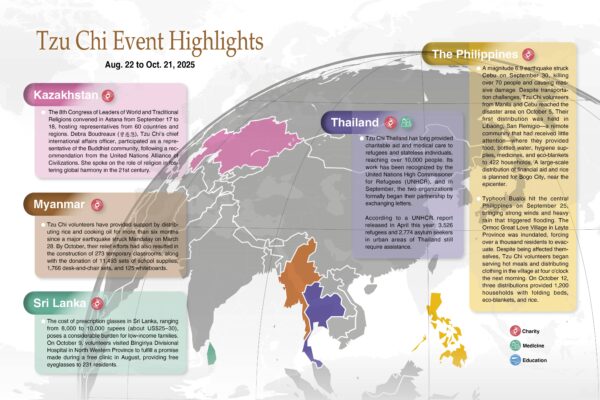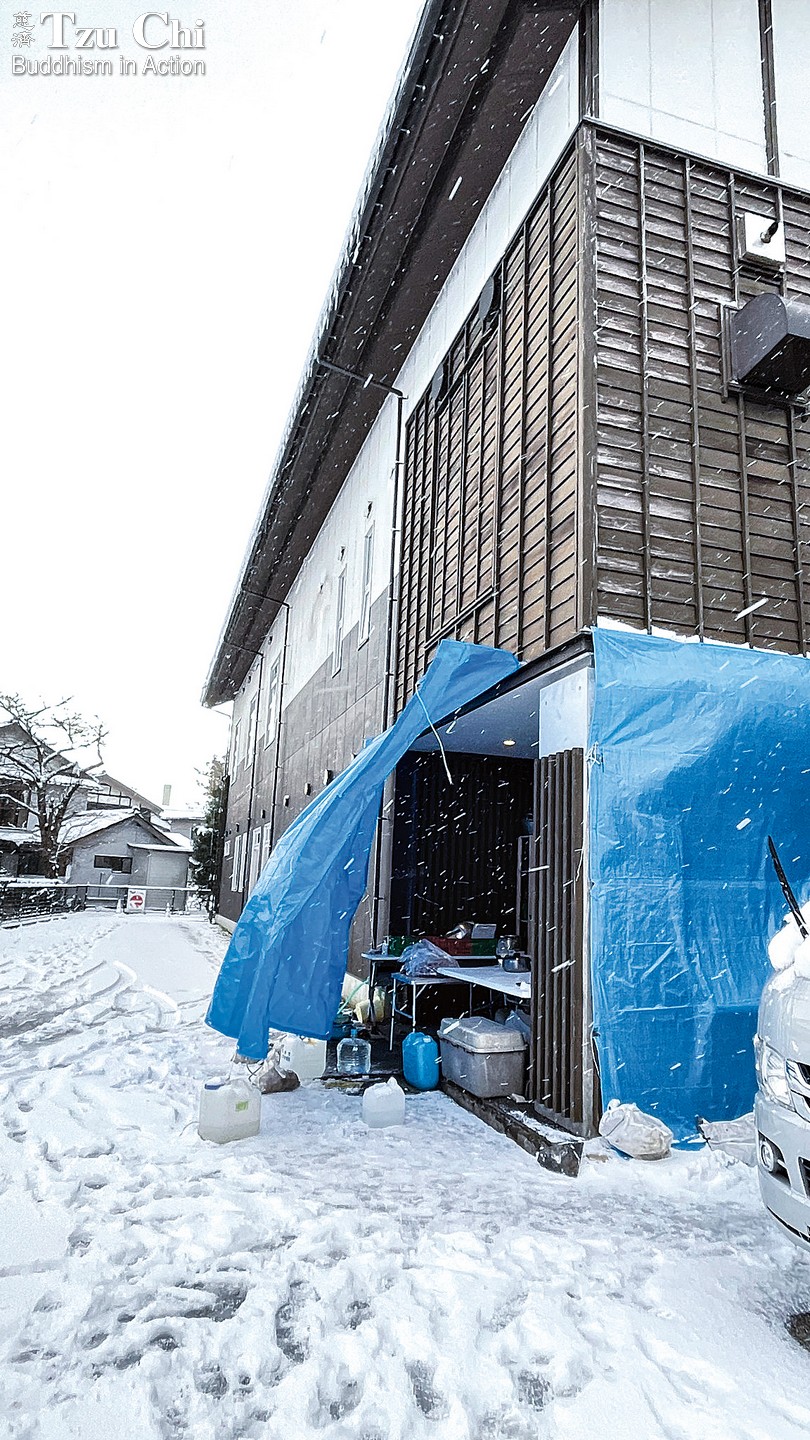
By Xu Li-xiang, CEO of Tzu Chi Japan
Abridged and translated by Wu Hsiao-ting
Photos courtesy of Tzu Chi Japan
Tzu Chi volunteers, overcoming challenging conditions, initiated a hot meal service in an area that was hit hard following a powerful earthquake on the Noto Peninsula in western Japan.
New Year celebrations in Japan are typically characterized by bustling crowds gathering at temples for their first shrine visits of the year, coupled with heartwarming reunions as city dwellers return to their hometowns to be with their parents or friends. But this year began on a somber note. At 4:10 p.m. on the first day of the year, a shallow, magnitude-7.6 earthquake rocked the Noto Peninsula in Ishikawa Prefecture, killing 240 people and causing extensive damage. The disaster cast a pall over what was supposed to be a joyous time.
Tremors from the massive earthquake were even felt by us in Tokyo, where the shaking measured magnitude 3. As tsunami warnings were issued, anxiety gripped everyone’s hearts. In that tense moment, Master Cheng Yen’s compassionate voice came through the phone, asking if we Tzu Chi volunteers in Japan were safe and sound.
Surrounded by the Sea of Japan, the picturesque Noto Peninsula is renowned for its lacquerware and seafood, but was largely unfamiliar to me and most other Tzu Chi volunteers in Japan. Despite our lack of knowledge of the area, we initiated a hot meal service there after the quake on January 13, setting up our first distribution point at the Sawayaka Community Center Pluto in the town of Anamizu. The community center had been repurposed as a shelter for survivors following the quake. Another group had already commenced meal distributions at the shelter, but they graciously relinquished their lunchtime slots to Tzu Chi. They were happy about this arrangement because they were short on volunteers themselves—just two individuals responsible for preparing a thousand meals each day.
Our volunteers worked in a temporary kitchen, sheltered by blue plastic sheets attached to the outer walls of the shelter. They had to endure all kinds of weather conditions in such a makeshift setup. The majority of evacuees at the community center were elderly, so their needs required special attention. For example, vegetables were cut into easily consumed, uniform sizes and dishes were cooked to a softer texture. The volunteers also prioritized the nutritional value of the food they prepared, and offered menu items including fiber-rich vegetables and protein-packed tofu dishes. Mrs. Arita, one of the meal recipients, expressed surprise that her mouth ulcers healed after consuming our meals. This revelation—perhaps demonstrating the power of vegetarian food—brought immense joy to the volunteers.
Our volunteers were initially nervous about how their food would be received, but their meals on the first day were met with gratitude and praise from the recipients. That day, Dr. Shimanaka Koshi, the superintendent of Anamizu General Hospital, visited our team. He came to us at the recommendation of Dr. Chen Wen-bi (陳文筆), a practicing physician in Ishikawa Prefecture and the chairman of the Ishikawa-Taiwan Exchange Promotion Association. The superintendent asked if we could expand our meal service to provide hot meals for his hospital staff, residents taking shelter at the town hall, and rescue teams from out of town. He explained that they had mainly been consuming instant noodles and rice balls since the earthquake, lacking access to hot meals. We agreed to his request without hesitation, thus adding another distribution point to our mission.
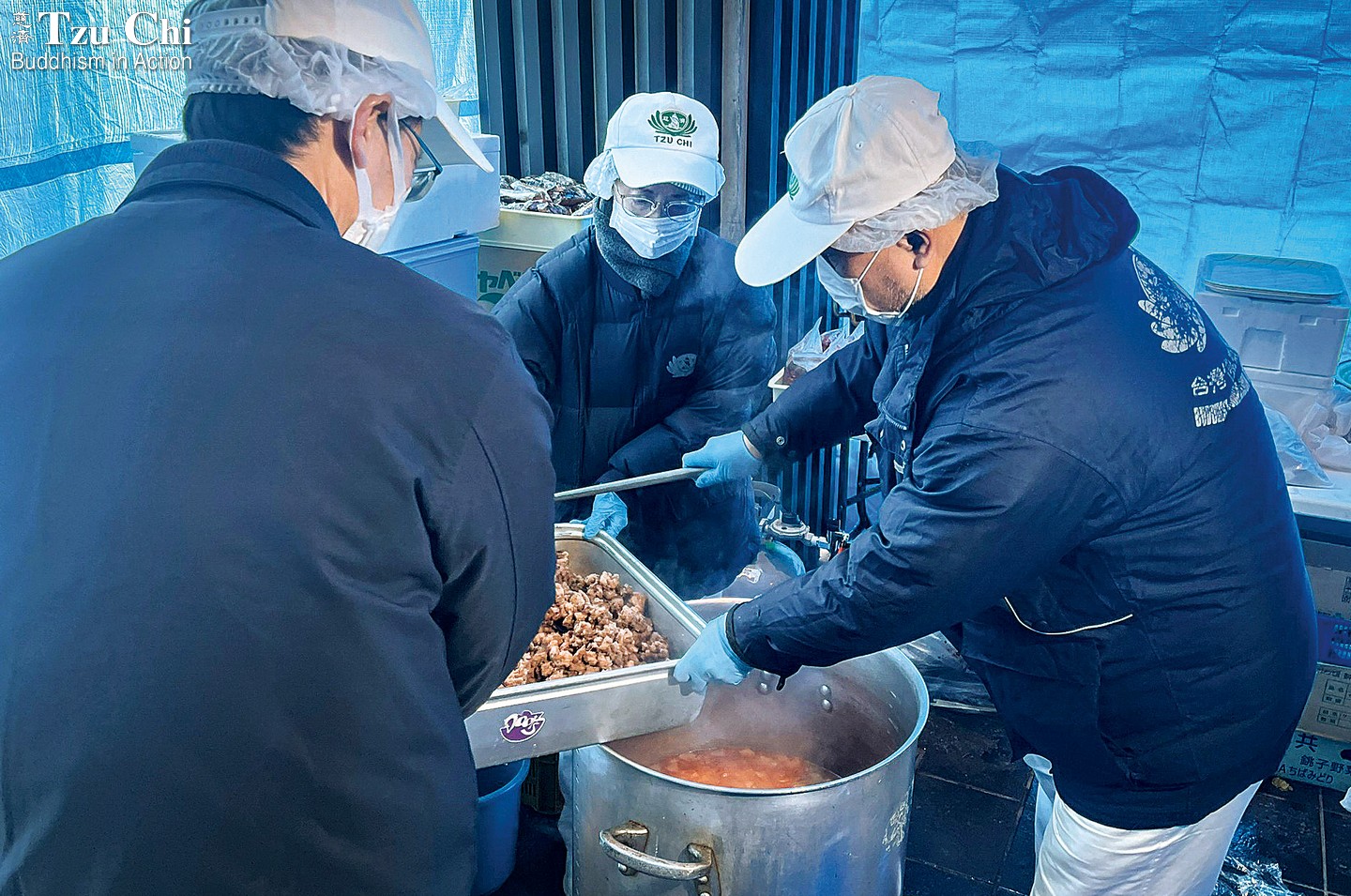
Volunteers prepare meals for hundreds of people in a makeshift setup at the Sawayaka Community Center Pluto.
Zhou Li-zhen
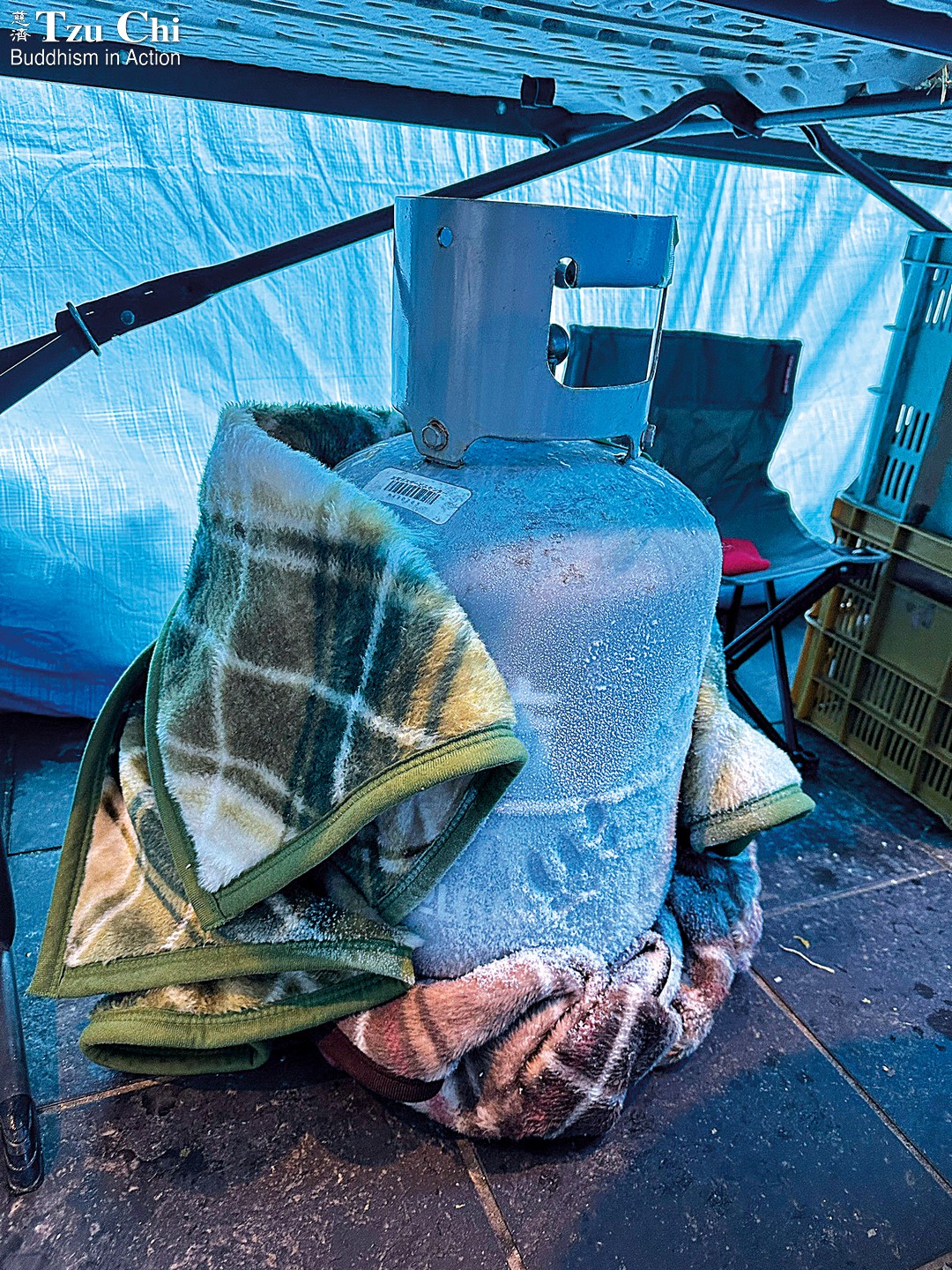
With temperatures at zero degrees Celsius in the early morning, the liquefied petroleum gas used for cooking froze, despite efforts to protect it with a blanket.
Gao Jun-zhe
But our work was not all smooth sailing. On the second day, what seemed like a straightforward task—cooking rice—soon turned into a nightmare. Snow fell on that day, which presented the volunteers with an unexpected challenge: the liquefied gas in the cylinder froze, leaving their rice uncooked.
Despite their rich experience in cooking for disaster victims, the undercooked rice left the volunteers immensely frustrated. Thankfully, local volunteers promptly provided udon noodles, resolving the predicament. When the same issue arose on the third day, the shelter supplied an electric rice cooker to help.
Our volunteers worked in relay teams, each group serving for five days before being relieved by a fresh team of volunteers. During the third team’s volunteer period, the electric rice cooker broke. A local group of volunteers showed the team how to cook rice using gas, but they were unfamiliar with the method and found it challenging. However, after learning the ropes, everyone rejoiced at acquiring another cooking skill.
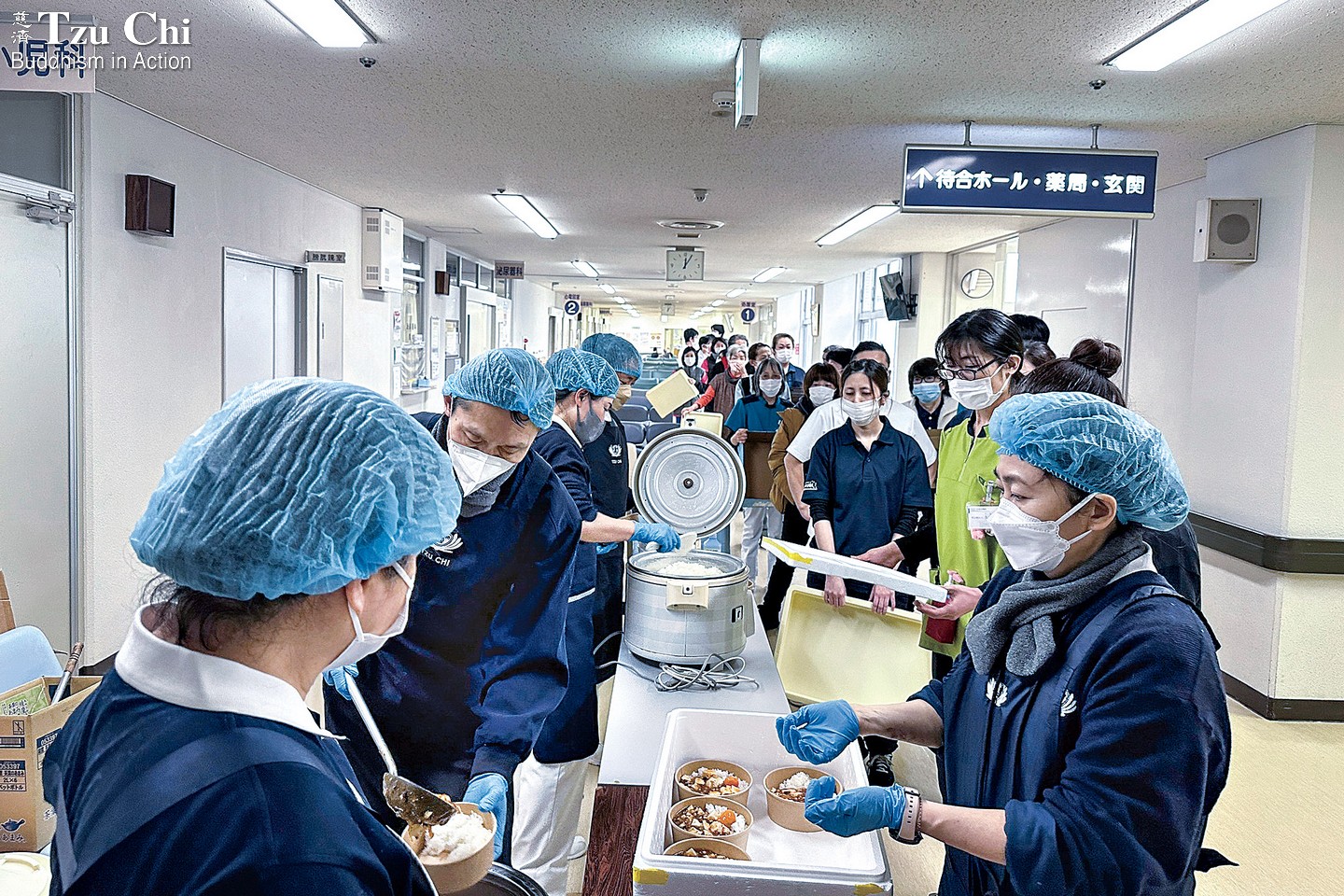
Volunteers served mapo tofu, a spicy Chinese dish, at Anamizu General Hospital on January 22, attracting many people to line up for meals.
Seizing opportunities to serve
After the earthquake, we managed to promptly provide services in the affected zone, despite the Japanese government politely declining international assistance and not yet accepting volunteer groups from other prefectures to serve in the disaster area. This was possible due to the support we received from various sectors and our extensive experience in preparing hot meals for disaster victims and the homeless over the years. However, the most crucial factor was the guidance from Master Cheng Yen, who deeply empathized with the suffering of the quake survivors. She motivated us to actively seek opportunities to serve in the disaster area. Our goal was simple: to provide warm, nutritious meals to the needy as soon as possible.
The day before our volunteers were set to depart for the disaster area to begin our meal service, our anxiety began to mount. Our accommodations had not yet been secured. We were advised to contact Dr. Chen Wen-bi and ask if he could check with the mayor of Nakanoto in Ishikawa Prefecture for help. Remarkably, within a mere ten minutes, accommodations were sorted out. Dr. Chen even joined us for the first day of our hot meal distribution.
Volunteers were put up in a century-old traditional Japanese house in Nakanoto. They found the local chilly conditions challenging, despite being from Tokyo, where occasional snowy weather was experienced. There was heating available at night, but it proved insufficient. For two consecutive nights, most of the volunteers huddled in their sleeping bags but still couldn’t shake off the cold enough to sleep. On the third day, the mayor sent emergency supplies for cold weather, including blankets. A volunteer also shared her experiences, saying that wearing warm down jackets to bed helped one sleep in the cold nights. Only then did the volunteers begin to sleep better.
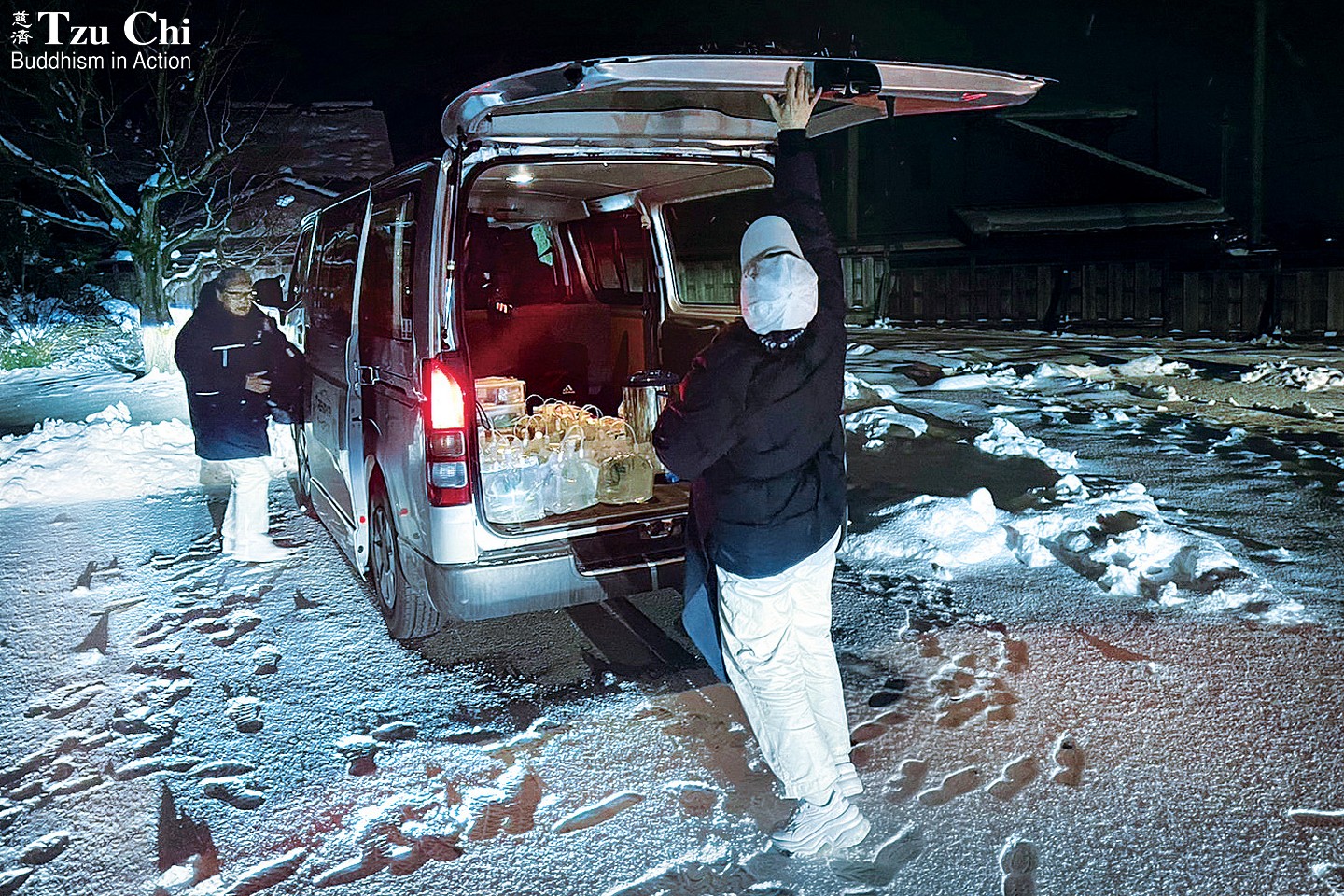
In late January, the quake-affected area was hit by days of heavy snowfall. Volunteers set out early in the morning to cook and serve hot meals for quake victims. While driving, they had to be cautious to avoid slipping on the snowy roads.

The distance between Nakanoto, where volunteers were staying, and Anamizu, where they served hot meals, is about 50 kilometers. Their daily schedule started with traffic congestion because road damage had restricted traffic to single lanes, and there were many rescue and relief vehicles on the road.
Zhou Li-zhen
The fact that we were staying in Nakanoto, despite being 50 kilometers (30 miles) from Anamizu, where our meal service was provided, provided a solution to the water shortage problem for cooking hot meals in the disaster area. Each night, volunteers filled water bags and washed and sliced vegetables at their accommodation, readying them to be transported to Anamizu the following day for cooking. The rhythmic sound of chopping echoed as volunteers prepared ingredients for over 500 servings of hot meals. They sometimes worked past midnight to meet menu requirements, even though they needed to set out by six in the morning. Their faces radiated with the joy of serving others, even with multiple pain relief patches on their bodies.
A videoconference on our earthquake relief efforts was held every day at 8:30 p.m. The conference often clashed with the volunteers’ vegetable chopping session. Worried they wouldn’t finish chopping in time, volunteers found themselves multitasking, peeling burdock roots, cutting potatoes, and shredding cabbage while participating in the meeting. Among other matters, volunteers shared during the meeting heartwarming moments from the day’s meal distributions, as well as tense instances where they worked to ensure everything was ready on schedule. Laughter filled the room, dispelling their fatigue and instilling courage for the unknown of the following day.
As teams rotated on the front lines, volunteers who couldn’t go to the disaster area continued Tzu Chi Japan’s regular activities, such as distributing food to the homeless, operating the Great Love Kitchen that served the disadvantaged, and providing care for needy households. Volunteers also hit the streets to raise funds to aid earthquake victims in Ishinomaki, located in Miyagi Prefecture, Shinjuku, located in Tokyo, Osaka, and other places.
Tzu Chi’s Relief Work Following Japan’s Noto Earthquake
A magnitude 7.6 earthquake rocked the Noto Peninsula in western Japan on New Year’s Day 2024, resulting in the loss of 240 lives and severely damaging or destroying tens of thousands of homes. Tzu Chi has since launched two phases of aid work to help survivors, providing hot meals and offering work relief opportunities.
◎Phase One
Duration: 17 days, from January 13 to 29
Locations: Anamizu General Hospital and the Sawayaka Community Center Pluto in Ishikawa Prefecture
Meal Recipients: evacuees, medical personnel at Anamizu Hospital, disaster relief or medical workers from various regions
Menu: over 20 varieties of dishes including eight-treasure rice, milk-stewed vegetables, Japanese-style borscht rice, sukiyaki rice, tomato mapo tofu, and others
Quantity: 7,129 servings
Mobilization: Each team of volunteers worked for five days, to be relieved by another team at the end of the five days. Four teams worked in succession, totaling 273 shifts.
◎Phase Two
Duration: commencing from February 16
Location: Anamizu General Hospital
Notable Events:
- Initiation of Tzu Chi’s first work relief program in Japan, providing employment opportunities for unemployed quake survivors by hiring them to assist in cooking, ensuring they receive assistance with dignity
- Opening of a Tzu Chi coffee station, providing coffee, hot tea, and hot cocoa for medical staff, patients, families, and evacuees
Returning
Our first phase of hot meal distributions ended on January 29. On February 16, volunteers returned to Anamizu Hospital to commence another phase of meal service. They launched Tzu Chi’s first work relief program in Japan at the same time by inviting four unemployed earthquake survivors to assist in meal preparation. Meals that day were served promptly at noon. A long queue had formed by the time they started. Representatives from various departments, carrying large food trays, eagerly awaited their meals while expressing joy at the sight of Tzu Chi volunteers once again. The hospital generously provided an unused break room in which volunteers could prepare hot beverages. Patients awaiting consultations and hospital staff who benefited from Tzu Chi’s service left message after message expressing gratitude for the hot drinks, meals, and the smiles. All of the positive feedback brought joy to the volunteers.
In January, following the earthquake, Master Cheng Yen frequently communicated with us volunteers in Japan, reminding us to adhere to government regulations while seizing opportunities to assist earthquake victims. Despite the bitter cold in the disaster area, every volunteer’s heart remained warm, guided by the Master’s compassion, as they did their best to ease the difficult time for those affected by the disaster.
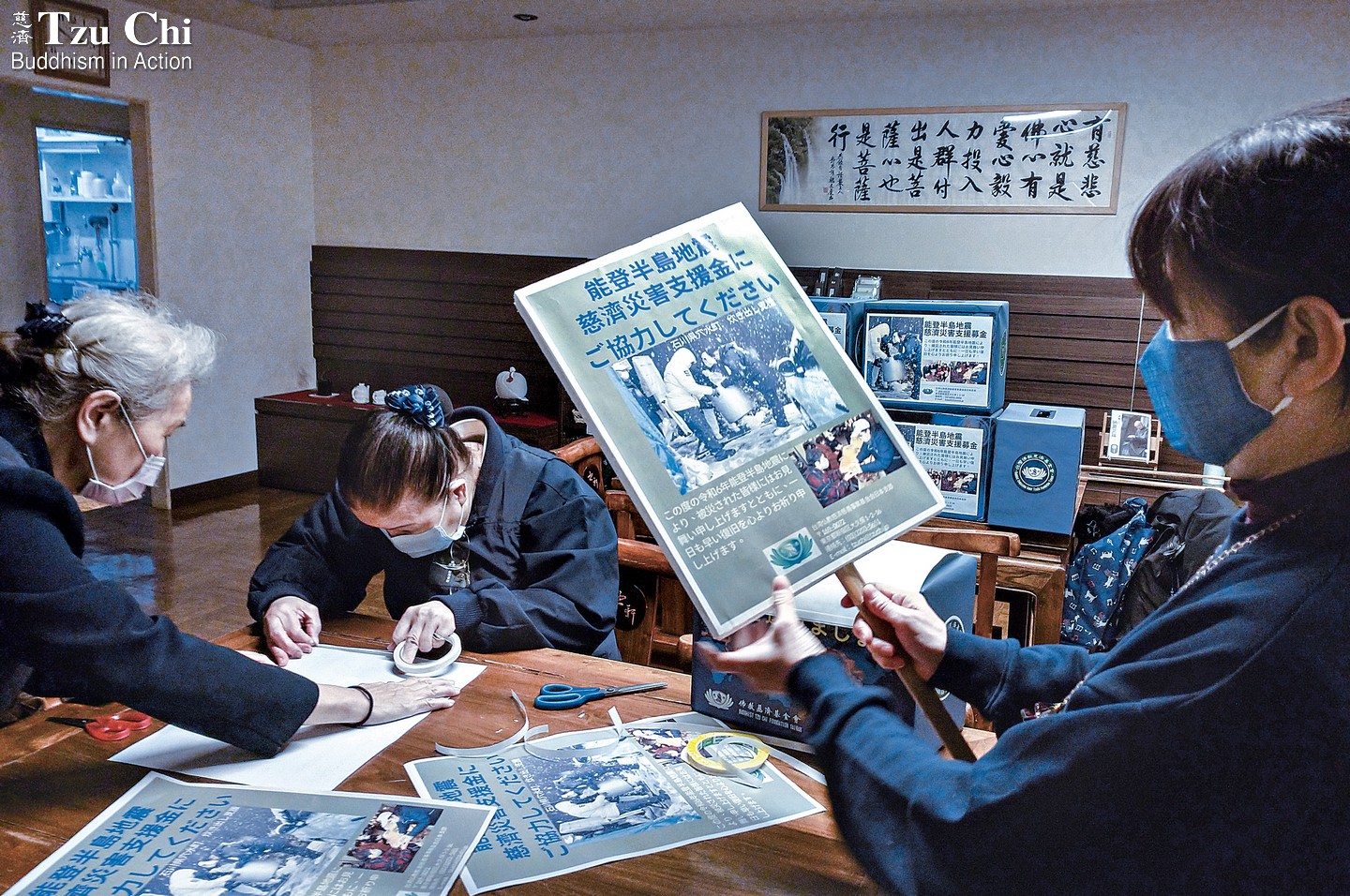
Volunteers staying behind at Tzu Chi’s Tokyo office prepare donation boxes and posters for street fundraising.
Lin Zhen-zi

